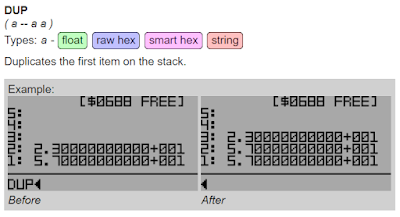
After a few months of progress, a demo version of this project is on my website. You can try out all the functionality of the calculator in your browser since it runs on my 6502 emulator. Below are some updates since the last post.
Software
The functionality of the calculator is close to complete. The Forth system is basically done and supports these new structures: IF/ELSE/THEN, DO/LOOP, BEGIN/AGAIN, and BEGIN/UNTIL. The only part missing from the Forth system is a way to look at the words and variables. Most Forths have a word called WORDS for this. My plan is to have a very simple list-based browser that will let the user delete words and will handle garbage collection. Logical operations like AND and OR have been implemented as well as CORDIC-based functions like SIN, COS, and TAN.
The firmware running in simulation is now a little more than 9KB, which is too big to fit on the calculator's 8KB EEPROM. The CORDIC routines especially take up a lot of room. I'll need to shave at least 2KB off of the firmware to get everything to fit and have room to implement the last few remaining features. My previous plan was to rewrite parts of the firmware in Forth. Now, I plan to also implement a byte-based virtual machine for floating point registers which should make the firmware much smaller and hopefully not sacrifice much speed.
Features I plan to add to the firmware:
- Word browser with garbage collection
- Simple graphing
- Improved numerical output on the stack display
- New words: ATAN, ACOS, ASIN, MOD, ^, E^, LN
There haven't been many updates to the hardware part of this project. The voltage regulator is a switching boost converter that generates 5v from three lithium AA batteries. These have good battery life for high current drain applications like this and also don't leak and damage the device the way alkaline batteries can. The boost converter will let me use the batteries down to a fairly low voltage, whereas a buck converter with four AAs would stop working when the batteries hit 1.3v and still have a lot of charge left. Picking the right capacitors and inductors for the regulator was a little tough since the exact ones listed in the datasheet have been discontinued. The few I picked to try seem to work but the voltage is too high when I run the regulator on a breadboard, so I'll have to wait until I solder it down to the circuit board to be sure.
Website
The new page on my website for the project has the firmware running in my 6502 emulator with documentation for the project below it. Some of the documentation sections, like the word list, took quite a bit of HTML and CSS to arrange, so I made a simple markup system to generate the pages. The information for the pages is stored in a markup text file that is easy to read and edit. A Python script reads the file and generates all the HTML files which would have taken a very long time to write by hand. I'm not sure what tools people generally use for this type of job. The system I made was a fun sub-project and really saved a considerable amount of time.
There were also a few small updates to the 6502 emulator that the calculator firmware is running on. One is a check for indirect jumps where the low byte of the address is 0xFF. There is a well known bug in the original NMOS 6502 where those addresses are calculated incorrectly. It turns out that the new check I added to the emulator is not really necessary since assemblers do their own check, but I'll leave it in for now. The HTML layout of the emulator pages is also more modular and cleaned up so it's easier to add new projects that use the emulator.
Conclusion
Now that this project is at a stopping point, I'm going to shift my attention to a new project that I'm working on for my resume. This won't take as long to build as a calculator, so hopefully I can shift back to this project when that was is finished.
No comments:
Post a Comment